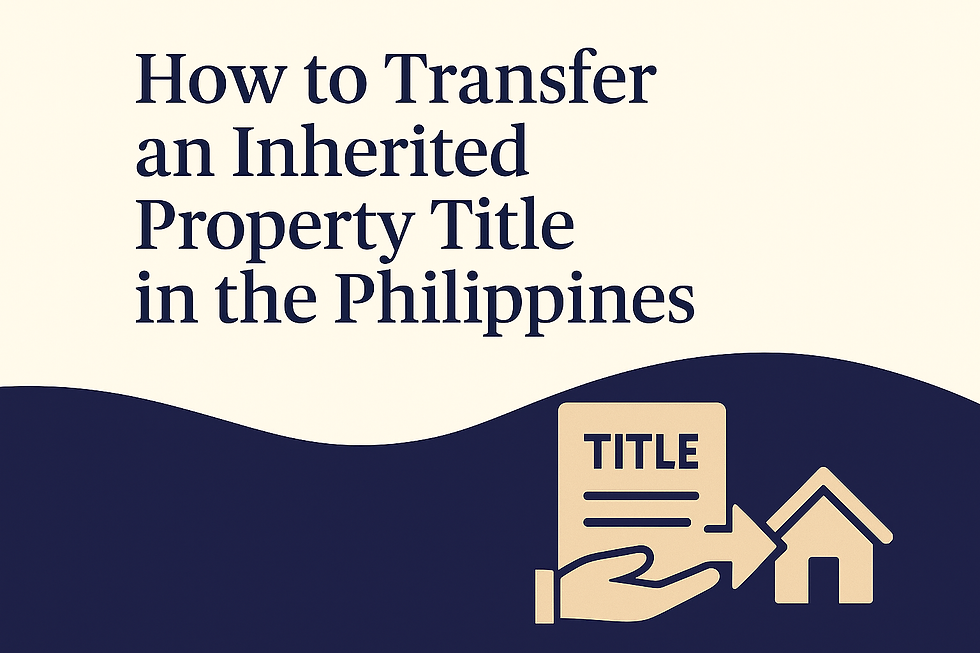How to Verify the Authenticity of a Land Title in the Philippines
- Cris Rosales Jr.

- Nov 2
- 3 min read
Updated: Nov 3
They say buying property is one of the biggest investments you’ll ever make — and they’re right. But it’s also one of the riskiest if you don’t do your due diligence.
With fake titles, double sales, and fraudulent transactions making headlines every now and then, it’s crucial to know how to verify land title Philippines records and check if a land title is genuine before signing or paying anything. So, let’s walk through this, step by step.

Step 1: Ask for a Copy of the Land Title
Start by requesting a copy of the property’s title from the seller — ideally the Owner’s Duplicate Copy of the Transfer Certificate of Title (TCT) or Condominium Certificate of Title (CCT).
Make sure it’s clear and complete. You’ll use this to check its authenticity later at the Registry of Deeds.
Tip: If the seller only gives you a photocopy, that’s fine for now — but never close a deal without seeing the original title.
Step 2: Secure a Certified True Copy (CTC) from the Registry of Deeds
Go to the Registry of Deeds (RD) where the property is registered and request a Certified True Copy of the title.
This is your best way to confirm if:
The title exists in the RD’s database, and
The details match the seller’s copy.
You can get the CTC over the counter, or through the Land Registration Authority (LRA) online portal via https://www.lra.gov.ph.
Once you get it, compare the entries line by line.
Step 3: Check for Red Flags on the Title
When you have both the CTC and the seller’s Owner’s Duplicate Copy, look out for these warning signs:
Font and Paper Quality
Genuine titles are printed on special paper with watermarks and security fibers visible when held against the light.
Serial Number & Seal
Located at the upper-left corner. It should be clear and embossed, not photocopied or printed.
Technical Description
The boundaries, lot area, and survey number must match the property’s location and documents.
Encumbrances and Annotations
Found at the back page of the title. Check for any mortgage, lis pendens (pending case), or adverse claim entries.
If there are annotations, don’t panic — just make sure you understand what they mean before proceeding. Some are harmless, others may block your transaction.
Step 4: Verify the Property’s Location and Boundaries
Visit the property site yourself. Bring a geodetic engineer, if possible, to confirm that:
The physical lot matches the technical description on the title, and
The boundaries are accurate (no encroachments or overlaps).
You may also check with the Municipal or City Assessor’s Office if the Tax Declaration corresponds to the same property stated on the title.
Cross-check:
✅ Owner’s name
✅ Property location
✅ Lot and block numbers
✅ Area size
Everything must match perfectly.
Step 5: Verify with the Land Registration Authority (LRA)
The LRA now offers a service called Aksyon Agad Query Verification, where you can verify land titles online.
Simply go to the LRA’s official website and input the Title Number and Name of Registered Owner. This helps you confirm if the title is:
Authentic,
Existing in the LRA database, and
Updated with the latest registration entry.
For peace of mind, you can even request a Certified True Copy directly from LRA offices or satellite branches (Registry of Deeds, Mall Service Centers, etc.).
Step 6: Watch Out for Common Scams
Fraudsters often use realistic-looking fake titles or forged deeds. Here are common red flags to keep an eye on:
Seller is not the registered owner (claims to be a “representative” without SPA).
Property offered at a suspiciously low price.
Title has erasures, blotches, or different inks.
Seller avoids personal meetings or delays showing original documents.
When in doubt, walk away — or verify further with a lawyer or licensed real estate broker.
Bonus: How to Spot a Fake Title Instantly
Checkpoint | Real Title | Fake Title |
Paper Quality | Special LRA paper with watermark and fibers | Plain bond paper or low-quality print |
Serial Number | Embossed and consistent with LRA format | Missing or printed |
Seal | LRA embossed seal visible | Printed or blurred |
Annotations | Typed and numbered properly | Messy or incomplete |
Verification | Found in LRA database | Not traceable |
Final Thoughts
A property deal should bring peace of mind, not sleepless nights. Verifying a title may seem tedious, but it’s the smartest move you’ll ever make as a buyer.
Remember: “A real deal begins with a real title.”
Never skip verification — because a few hours of checking can save you from losing millions later.
Author’s Note
Written by Cris Rosales Jr., founder of A Little Bit of Everything in Life — helping Filipinos navigate real estate, finance, and life with clarity and con



Comments